Bell Frames #
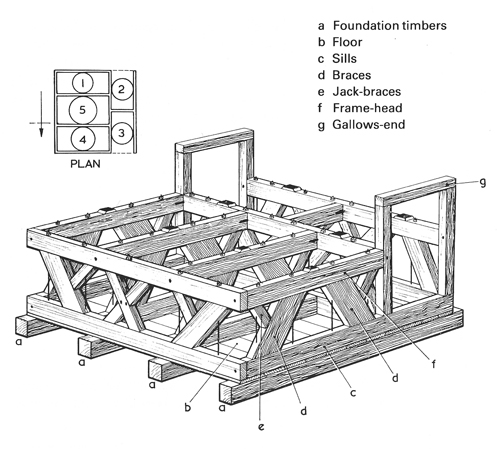
The bell frame is the structure which supports the bells. It fulfils several main roles:
- It provides rigidity with an economy of materials and compactness
- It transmits the vertical and horizontal forces arising from the movement of the bells to the tower walls
- It provides a fair circle of ropes in the ringing room
The design of bell frames has developed over the years as the need changed from simple chiming to full circle ringing, and as newer materials became available. The history is fascinating but outside the remit of this document. Here, we will describe the types of frames most likely to be encountered and the care which a Typical Steeple Keeper can provide in each case.
The Title Picture identifies the parts of a timber frame and provides a good starting point. A more complete account of the development of bell frames is given in Chapter 4 of the Central Council of Church Bell Ringers Towers and Bells publication.
Types of Bell Frames #
Timber frames #
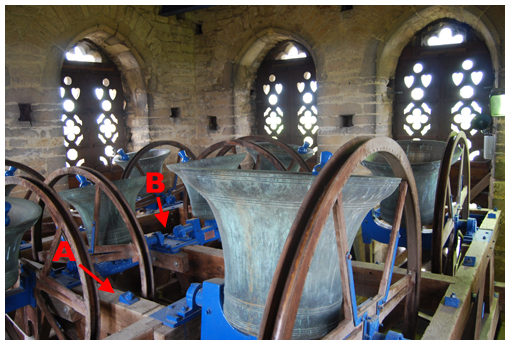
Figure 1: Timber frame, showing tie bolts (A) and bearings (B)
The frame shown in Figure 1 is dated c1899 but has modern fittings. Note the tie bolts (A) and the ball bearings (B) mounted on the frame-heads. Very early timber frames relied on morticed joints on the braces between the sills and frame-heads but, with shrinkage of the wood, these did not provide sufficient rigidity of the frame. Timber frames now rely on tie bolts for rigidity.
The excellent Title Picture shows vertical tie bolts although, unfortunately, they are not labelled.
New timber frames are uncommon now but may still be supplied. In many cases, steel girders replace the timber foundation beams.
Composite frames #
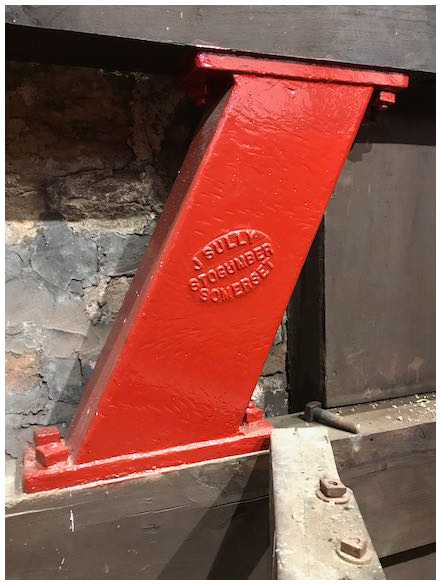
Figure 2: Cast iron cross brace on a timber frame
With the availability of cast iron, composite frames were introduced with iron braces bolted to timber sills and frame-heads (Figure 2). Several of these are still in use and, if well maintained, provide rigid frames.
Iron and steel frames #
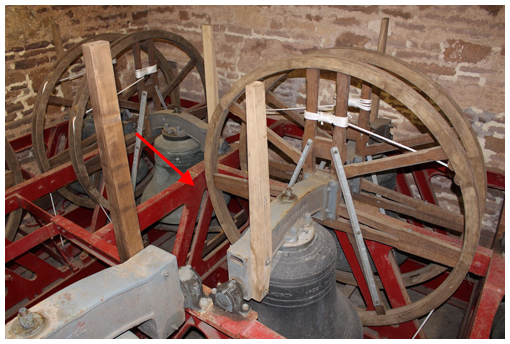
Figure 3: Low-sided metal frame
Iron and steel frames may be ‘low-sided’ as shown in Figure 3, following the pattern of a timber frame but with the sill, frame-head and braces replaced by cast side-frames (arrowed) held together with steel girders.
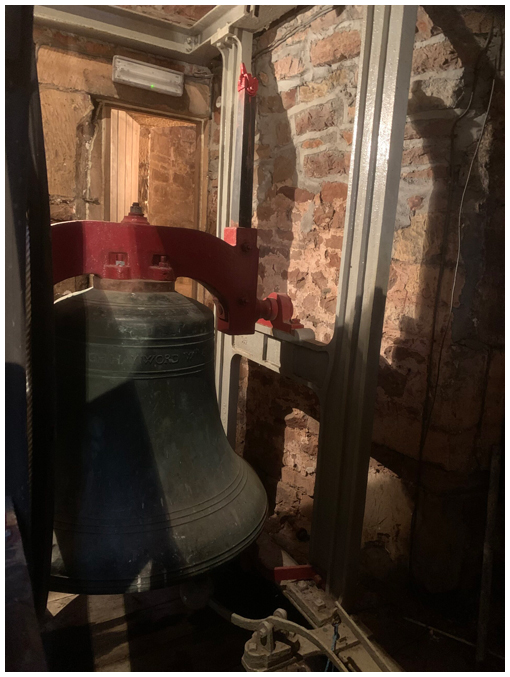
Figure 4: ‘H’ frame
An alternative is the ‘H’ frame, shown in Figure 4. As you can see, the top of the frame is above the bell, with the bearings at half-height. This arrangement is often used where space is limited and the bells are hung in two or more tiers (in this tower the lighter bells are hung in a higher tier) but ‘H’ frames all on one level are not uncommon.
Radial frames #

Figure 5: Radial frame at Washington Cathedral
For completeness, we should mention radial frames (Figure 5). The traditional design, with bells swinging at right angles, can result in torsional stress on the tower and this is minimised in the radial design. This design also provides a simple and precise rope circle. This is taken still further at Liverpool Cathedral, where the radial frame is constructed from reinforced concrete. But such frames take up much more space, usually in towers constructed for the purpose, and are unlikely to be encountered by a Typical Steeple Keeper.
Care of Bell Frames #
Well-built bell frames will last for years and it is all too easy to take them for granted. But all frames can be subject to long-term degradation and the Steeple Keeper – who probably has a closer contact with the frame than most – fulfils a vital role in their care.
Timber frames #
As said above, tie bolts are essential for maintaining the rigidity of a timber frame and a check on their tightness must be built into the maintenance schedule, preferably during a dry part of the year when shrinkage of the wood will be greatest.
When tightening the nut on a tie bolt, you should attempt to slacken the nut first. This checks that the nut is not simply rusted into place or has bottomed-out on the thread. If the latter, add washers below the nut.
Decay generally results from long-term dampness. In the lower part of the frame, this can be where timber foundation beams enter the tower wall or where there are accumulations of dust or rubbish. The Steeple Keeper must ensure that the areas around all timbers are kept clean with no obstacles to ventilation. Beetle attack is seldom found in dry timbers.
Decay in the top members of the frame is usually due to a leaking roof or rain driving in through the louvres. This is a matter for the church authorities.
Birds, usually pigeons or jackdaws, must be excluded ruthlessly from towers as their nests encourage damp and harbour fungus and insects. Note that Death Watch Beetles may be found in the dead hedgerow sticks favoured by jackdaws for their nests.
Any cases of decay or beetle attack will require specialist treatment.
Iron and steel frames #
Metal frames require little maintenance, although checks should be made for loose or missing fastenings (usually a rare occurrence). However, these frames need to be cleaned and repainted every 10 or 20 years. This is not a simple job, and the use of a Bell Hanger should be considered. Many girders may be located close to the walls, making their outer surface difficult to access, and vulnerable points where girders meet the tower walls may require the use of ladders or scaffolds.
Lightning protection on metal frames #
Lightning strikes on high buildings like church towers are not unusual, and all towers should be protected by properly installed and regularly checked lighting conductors, which take the charge to earth (electrically and literally). While this is not the responsibility of the ringers, there is a ‘connection’, in that metal bell frames must be bonded to the lightning conductor system. An example is shown arrowed in Figure 6, where the bond is to the bottom of one of the main support girders. Details may vary on other installations.

Figure 6: Bonding of a metal bell frame to the church lighting conductor
The reason for bonding is that lightning will take the path of least resistance to earth. For a strike on an unbonded metal frame, that path may be down damp ropes or clock hammer linkages. This could result in fires, damage to masonry, electric shocks and damage to electrical equipment in the church.
A properly installed bond should not deteriorate but, as the Steeple Keeper is likely to see the bell frame more often than other church officials, it would be prudent to identify the site of the bonding point and include a check on it in the maintenance schedule. Any problem should, of course, be reported immediately to the church authorities.
A more detailed description of lightning protection and bell frames can be found in this downloadable PDF file.
Image Credits #
| Figure | Details |
|---|---|
| Title Picture | The parts of a typical timber bell frame. (Drawing © the late J G M Scott, used with permission from his family) |
| 1 | Timber frame at Thame, Oxfordshire. Entry in the Bells and Installations round of the Central Council photographic competition. (Photo: Stephen Hoar) |
| 2 | Cast iron cross brace in the composite frame by John Sully of Stogumber at Almondsbury, South Glos. (Photo: Robin Shipp) |
| 3 | Low-sided metal frame (Whitechapel 1996) at Thornbury, South Glos. (Photo: Robin Shipp) |
| 4 | ‘H’ frame (John Taylor & Co, 1903) at Long Ashton, Somerset. Entry in the Bells and Installations round of the Central Council photographic competition. (Photo: Will Rogers) |
| 5 | Radial Frame (Mears & Stainbank, 1962) at Washington Cathedral, USA. Entry in the Bells and Installations round of the Central Council photographic competition. (Photo: Lian von Wantoch) |
| 6 | Bonding of the bell frame to the lightning conductor at Thornbury, South Glos. (Photo: Robin Shipp) |
Next Chapter - Previous Chapter
Disclaimer #
Whilst every effort has been made to ensure the accuracy of this information, neither contributors nor the Central Council of Church Bell Ringers can accept responsibility for any inaccuracies or for any activities undertaken based on the information provided.
Version 1.1.1, February 2024
© 2022 Central Council of Church Bell Ringers